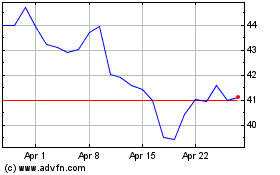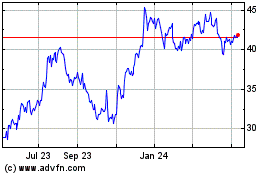FDIC List Shrinks, Earnings Soar - Analyst Blog
November 23 2011 - 7:50AM
Zacks
The number of banks on the Federal Deposit Insurance
Corporation’s (FDIC) list of problem institutions saw a sharp
decline for the second straight quarter to 844 in the
July-September period from 865 in the preceding sequential period,
federal regulators reported Tuesday. This represents the second
quarterly drop since 2006.
Things looked a lot brighter in the third quarter given the drop
in the problem list accompanied by the highest level of overall
profit earned by FDIC insured banks in more than four years. This
also represents profits earned by banks for the ninth straight
quarter.
The problem list includes banks that face imminent failure due
to low capital support, though some may survive and pull out of the
crisis. As of now, only less than a quarter of the banks on FDIC's
problem list have actually failed. This ratio may however change if
the pace of bank failures increases.
Size of Problem Banks
Most of the problem banks are small institutions. Total assets
of these banks decreased to $339 billion at the end of the third
quarter from $372 billion at the end of the previous quarter. This
nevertheless represents a phenomenal 57-fold jump from $6 billion
in assets of 50 problem institutions in 2006.
Pace of Bank Failures
There have been 90 bank failures so far this year, preceded by
157 in 2010, 140 in 2009 and 25 in 2008. On a cautionary note,
increasing loan losses on commercial real estate could trigger
hundreds of bank failures in the coming years. However, considering
the course of failure so far this year, the FDIC does not expect
the number of failed banks in 2011 to exceed the 2010 tally.
While the financials of a few large banks have been stabilizing
on the back of an economic recovery, the industry is still on shaky
ground. Nagging issues like rock-bottom home prices along with
still-high loan defaults and unemployment levels continue to
trouble such institutions.
Lingering effects of the financial crisis continue to weigh on
many banks. The need to absorb bad loans offered during the credit
explosion made these banks susceptible to severe problems.
Further, the repeated risk-taking of bailed out banks ultimately
resulted in further threats to the system. Risky loans and market
uncertainty aggravated the risk of bank failures even further.
Role of FDIC
The FDIC insures deposits at 7,437 banks and savings
associations in the nation as well as promotes the safety and
soundness of these institutions by addressing risks associated with
them. The number is, however, down from 7,513 in the prior quarter.
Now the problem banks represent about 11.3% of the total number of
institutions covered by the FDIC. When a bank fails, the agency
reimburses customers for deposits of up to $250,000 per
account.
Financial Health of FDIC
Though the FDIC has managed to shore up its deposit insurance
fund over the last few quarters, the ongoing bank failures have
kept it under pressure. However, at the end of the third quarter,
the fund was in surplus for the second straight quarter. Also, the
balance increased to $7.8 billion from $3.9 billion at the end of
the prior quarter. The improvement in fund balance was aided by a
moderate pace of bank failures and assessment revenue.
Record Profit: A Confidence Booster
Besides the heartening decline in the list of problem
institutions, the highest level of profit from FDIC-insured banks
significantly impresses us. The consolidated third quarter profit
of FDIC-insured banks came in at $35.3 billion, up 22.6%
sequentially and 48.3% year over year. The year-over-year rise was
primarily driven by improving asset quality and lower loss
provisions.
However, in terms of numbers, only a handful of banks, with
assets exceeding $10 billion,generated the major portion (more than
three-fourth) of the consolidated profit during the quarter. These
are primarily the large banks, of the likes of JPMorgan
Chase & Co. (JPM), Wells Fargo &
Co. (WFC), The Goldman Sachs Group Inc.
(GS) and Citigroup Inc. (C), which were supported
by government bailout money and low borrowing rates. On the other
hand, smaller banks not doing too well failed to make any
meaningful contribution.
Consolidation to Continue
With repeated bank failures, consolidation has become the
industry trend. For almost all of the failed banks, the FDIC enters
into purchase agreements with healthy institutions. When Washington
Mutual collapsed in 2008 (branded as the largest bank failure in
the U.S. history), it was acquired by JPMorgan Chase & Co. The
other major acquirers of failed institutions since 2008 include
U.S. Bancorp (USB) and BB&T
Corporation (BBT).
We expect the pace of consolidation to more or less replicate
the pace of bank failures,making way for an oligopolistic market.
Less competition could even put the country’s wealth and welfare
optimization at stake.
BB&T CORP (BBT): Free Stock Analysis Report
CITIGROUP INC (C): Free Stock Analysis Report
GOLDMAN SACHS (GS): Free Stock Analysis Report
JPMORGAN CHASE (JPM): Free Stock Analysis Report
US BANCORP (USB): Free Stock Analysis Report
WELLS FARGO-NEW (WFC): Free Stock Analysis Report
Zacks Investment Research
US Bancorp (NYSE:USB)
Historical Stock Chart
From May 2024 to Jun 2024

US Bancorp (NYSE:USB)
Historical Stock Chart
From Jun 2023 to Jun 2024
